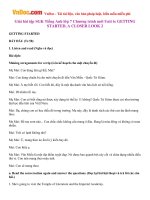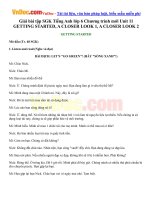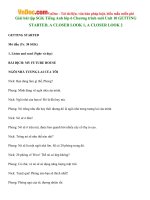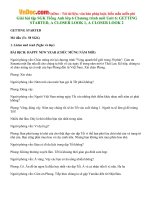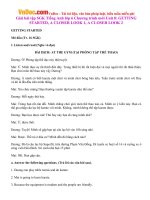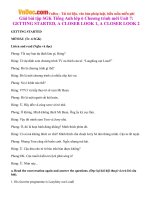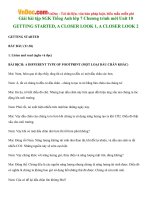Arguments for material nihilism taking a closer look
Bạn đang xem bản rút gọn của tài liệu. Xem và tải ngay bản đầy đủ của tài liệu tại đây (138.74 KB, 66 trang )
ARGUMENTS FOR MATERIAL NIHILISM: TAKING A
CLOSER LOOK
CHONG BAO SHEN, KENNETH
(B.Arts with Honours, NUS)
A THESIS SUBMITTED
FOR THE DEGREE OF MASTER OF ARTS
DEPARTMENT OF PHILOSOPHY
NATIONAL UNIVERSITY OF SINGAPORE
2015
I hereby declare that the thesis is my original work and it has
been written by me in its entirety. I have duly acknowledged all
the sources of
information which have been used in the thesis.
This thesis has also not been submitted for any degree in any
Chong Bao Shen Kenneth
Page 2 of 66
DECLARATION
I hereby declare that the thesis is my original work and it has
been written by me in its entirety. I have duly acknowledged all
information which have been used in the thesis.
This thesis has also not been submitted for any degree in any
university previously.
Chong Bao Shen Kenneth
January 2015
I hereby declare that the thesis is my original work and it has
been written by me in its entirety. I have duly acknowledged all
information which have been used in the thesis.
This thesis has also not been submitted for any degree in any
Page 3 of 66
ACKNOWLEDGEMENTS
A huge thanks to my supervisor A/P Mike Pelczar, whose patience
and insights made this paper possible. A big thanks too to various
staff, students, and administrative personnel in the NUS
Philosophy Department, for supporting this endeavor.
Page 4 of 66
CONTENTS
Summary 5
Chapter 1: Introduction 6
Chapter 2: The Special Composition Question 13
1. Van Inwagen’s Argument 14
2. Reductionism 29
3. Summary 35
Chapter 3: The Overdetermination Argument 37
1. Merricks’ Overdetermination Argument 37
2.
Some objections 40
3. Reductionism 49
4. Summary 52
Chapter 4: The Problem of the Many 54
1. The Problem stated 55
2.
Some responses 56
3. Sorites and Reductionism 63
4. Closing remarks 65
*References are provided at the end of each chapter
Page 5 of 66
Summary
Material nihilism, also known as compositional nihilism, is the view that there
are no such things as material objects with proper parts – that is, there are no
such things as physical composite objects as tables and mountains. In my
paper, I will present and examine in detail three contemporary arguments often
associated with the view. Peter van Inwagen argues for the view because he
thinks it provides the best answer to what he terms the Special Composition
Question. Trenton Merricks argues that there are no material composite
objects on pain of causal overdetermination. And Peter Unger provides an
updated twist of Sorites-style reasoning for material nihilism in what is known
as the problem of the many. I will examine these arguments through the lens
of reductionism; in doing so I will point to ways in which the ongoing debate
over material nihilism can be further developed.
Page 6 of 66
Chapter 1: Introduction
Material nihilism is the view that there are no material objects with proper
parts. This view is sometimes referred to as ‘compositional nihilism’, or,
simply, ‘nihilism’. I choose to term it ‘material nihilism’ only because it
would be good to focus our attention on concrete, material objects as opposed
to abstract entities. By ‘material’ I mean ‘physical’, and by that I mean ‘has
extension in space and time’. A material object X has proper parts x
1
and x
2
if
and only if x
1
and x
2
are parts of X, and x
1
is not identical to X and x
2
is not
identical to X. Parthood should be understood here in a basic, intuitive way, in
a way similar to how we consider the four legs of a table to be parts of the
table. We might take this to immediately render material nihilism false, for
obviously we do consider the four legs of a table to be proper parts of that
table, so there are material objects with proper parts. A material nihilist would
deny there is a material object that has the four legs as parts to begin with.
There are a number of reasons why a material nihilist might think there is no
such material object (that is, the table) to begin with. He might object to the
presence of such composite objects because he might think there is no
principled, unobjectionable way in which the process of composition can be
defined or understood. Or he might think that composite objects would
overdetermine effects their parts sufficiently caused. And on pain of accepting
such systematic overdetermination we ought to hold there are no composite
material objects. He might also object to the existence of such objects as he
might think that whatever reason we have for positing a table here, is as good
a reason for positing many more tables in the vicinity; but there aren’t many
Page 7 of 66
more tables in the vicinity, so we don’t have a good reason for claiming the
existence of our initial table. These lines of reasoning have been advanced by
Peter van Inwagen, Trenton Merricks, Peter Unger, and Peter Geach. We will
look at their arguments in detail in chapters two, three and four respectively.
The objective of this paper is twofold. (1) I hope to present a close, careful and
comprehensive look at the aforementioned arguments; it is my view that a
holistic yet thorough analysis of these arguments is absent from the existing
literature. (2) Building on (1), I hope to lay the groundwork for a better
understanding of what exactly material nihilism is, and who its targets are. In
particular, we will look at various
reductionist replies one can make to these
nihilistic arguments. By and large, it might be thought that
reductionism
instead of material nihilism would be the more sensible position to take. Why
eliminate composite objects when we can simply reduce them to simpler
entities? As it will emerge, this is a legitimate question to ask. At the same
time, however, the debate between reductionists and material nihilists is a
muddy one. Reductionism comes in several forms, and as we shall see, not all
of our nihilistic arguments are firmly opposed to all forms of reductionism. Or,
more precisely: not all of our nihilistic arguments seem to have a firm
response to all forms of reductionism. This might be thought to be a problem
for material nihilism. And perhaps it is. But in any case, understanding what
sorts of reductionism material nihilism is up against will ultimately be useful
in advancing the debate between material nihilists and their more temperate
counterparts the reductionists. With this in mind, I will spend the rest of this
chapter outlining the various types of reductionism.
Page 8 of 66
I propose two broad categories for reductionism in these debates: N-
reductionism
, and N+1-reductionism
1
. N-reductionists hold that there are
tables and other composite material objects, but these objects are nothing
“over and above” their constituent parts. An atom made of two simple
particles – where a simple is a fundamental-level object that has no proper
parts – is nothing “over and above” those two particles. So if we were to count
the number of objects here, we would say there are only two objects – the two
particles. There is loosely speaking a third object, the atom, but to count three
objects in this scenario would be akin to counting all the parts of a chicken,
and the entire chicken itself. More generally, for any N simple particles we
count, there would be N objects present, no more and no less, no matter how
these particles might be grouped or “fused” together. Hence the name N-
reductionism.
N+1-reductionism, on the other hand, holds that in at least some
circumstances, there are composite material objects “over and above” their
constituent material parts. In our atom example, they might hold there are
three objects present – the two particles and the atom itself. More generally,
for any N simple particles we count, if they compose a single material object,
then the N+1 reductionist would say there are N+1 objects present. Now, we
might think it strange why anyone would count in such a manner (I will come
to the reductionist bit in a moment). As far as I can see, one motivation for
doing so is to justify the distinctness between the whole and the collection of
its parts. Our atom might have certain
emergent properties none of our simple
1
To be sure, the N and N+1-views that I’m about to mention are not views specifically tied to
reductionism. They are views which can be taken independently of reductionism.
Page 9 of 66
particles possess, for example; and our chicken might possess a different set of
persistence conditions from the collection of its parts. It might survive
debeaking for example, but the collection of its parts can’t. N+1 reductionists
might take this to show that there is a wholly distinct object “over and above”
its constituent parts.
Let’s group reductionisms which hold the N-view under the label
complete
reductionism
. And let’s group reductionisms which hold the N+1-view under
the label
emergentist reductionism. The key difference between these two
views, it should be reemphasized, lies in how many objects one thinks there
are in the vicinity of an apparent composite object. Nihilists and complete
reductionists alike count N, where N is the total number of simple objects in
the vicinity; emergentist reductionists count N+1.
Complete reductionism can be further split into two categories:
identity
reductionism
, and simple reductionism. An identity reductionist holds that the
composite whole is identical to the set containing all and only its apparent
parts. We can clearly see why identity reductionists are of the N-view. It’s
hard to accurately characterize simple reductionism, but broadly simple
reductionists hold that
X reduces to Y if and only if X exists wholly in virtue of
Y.
It will be best to think of this in terms of examples. A common one would
be simple reductionism about heat: there is such a thing as heat, but it exists
wholly in virtue of molecular kinetic energy. Or mental phenomena: there are
Page 10 of 66
such things as mental phenomena, but they exist wholly in virtue of physical
phenomena
2
.
Emergentist reductionists hold the N+1 view, and that whatever an object is
being reduced to can
reductively explain the object being reduced, where to
reductively explain something is understood as: Y reductively explains X if
and only if we can wholly understand X just in Y-terms. In other words,
understanding Y is all we need to understand X. It is a matter of some debate
whether reductive explanation is logically equivalent to simple reductionism
3
.
In this paper they will not be treated as being logically equivalent, but nothing
too much will turn on this. If it turns out they are indeed logically equivalent,
then remarks applied to one can equally be applied to the other.
I believe it is important to sort reductionism out as above, as too often nihilists
have grappled with reductionism without being fully clear on what they are
dealing with. Merricks (2001), for example, writes:
Composition as identity is false. So every composite object is distinct from – i.e. not
identical with – its parts. So every such object is something ‘in addition to’ its parts.
- pg 28.
In denying composition as identity Merricks is effectively denying identity
reductionism; but his alternative is to shift to emergentist reductionism (or at
least the N+1 view). If complete reductionism is a viable alternative however,
then Merricks’ conclusion is unwarranted: composition as identity could be
2
Here’s a stab at a more precise definition: X reduces to a spatiotemporal configuration X
1
if
and only if a spatiotemporal complex X
1
is understood as the arrangement of particles
ostensibly constituting the existence of X; and necessarily, X exists if X
1
esists. I’m not sure if
all complete reductionists would agree with this characterization, so sticking with the
preceding would do for our purposes.
3
Kim (2008) seems to think so. Some of the material just mentioned is owed to his paper.
Page 11 of 66
false, and every composite object is distinct from its parts, but it’s false that
every such object is something ‘in addition to’ its parts.
Elsewhere, Rosen & Dorr in their paper “Composition as a Fiction” make a
case for material nihilism (or what they call compositional nihilism) – but one
of the key contenders they consider is emergentist reductionism, or what is
also referred to as “naïve common sense”, which puts forth similar counting
claims as brought forth for emergentist reductionism earlier (see Rosen &
Dorr, 2002: 151-152). Yet we might think complete reductionism, insofar as
it’s a coherent thesis on its own, would be the stronger contender, so the
authors have missed the mark there. Further, in the course of this paper we
will see that various moves made in defense of nihilism are effective against
emergentist reductionism, but have less force against simple reductionism.
A couple of last notes. In the rest of this paper I will discard identity
reductionism when talking about complete reductionism. The sole reason is
that I’m inclined to think identity reductionism is virtually indistinguishable
from material nihilism. To be sure, identity reductionism maintains there is a
composite whole; nihilism says there isn’t. But since nihilists would agree
there is a set containing all and only of that object’s apparent parts, agreeing
there is a composite whole in this sense doesn’t seem to undermine the spirit
of nihilism. Whether simple reductionism itself is indistinguishable from
material nihilism is a tougher call; perhaps ploughing through the fields is the
only way to decide for ourselves. There may be other ways of cashing out
reductionisms holding the N-view; but if so, I’m not aware of what they are.
Page 12 of 66
With identity reductionism discarded then, I will proceed to take complete
reductionism to be synonymous with simple reductionism. Also unless
specified, I will use the terms ‘reductionism’ or ‘reductionist’ to refer to
reductionisms of both the N and N+1 variety, and adherents thereof.
References
Kim, J. (2008). Reduction and Reductive Explanation: Is One Possible Without the
Other? In J. (. Hohwy, & J. (. Kallestrup,
Being Reduced: New Essays on Reduction,
Explanation, and Causation
(pp. 93-114). New York: Oxford University Press.
Merricks, T. (2003).
Objects and Persons. New York : Oxford University Press.
Rosen, G., & Dorr, C. (2002). Composition as a Fiction . In R. M. Gale,
The Blackwell
Guide to Metaphysics
(pp. 151- 174). Cornwall: Blackwell Publishers Ltd.
Page 13 of 66
Chapter 2: The Special Composition Question
Peter van Inwagen, in his book Material Beings, argues that only simples and
living organisms (which are composite objects) exist. In this chapter I will
provide a reconstruction of his argument and put forth some reductionist
remarks. We should note here that van Inwagen in no way puts forth the
argument of his book along the following logically valid lines explicitly. I do
believe, however, that he was driven to his conclusion along these very lines,
and so while they may seem to depart from his work in letter, I believe they
remain true to his work in spirit. Summarizing van Inwagen’s position in the
following way will indeed give us a good, comprehensive handle on his book-
long treatise.
In a nutshell, van Inwagen thinks that only simples and living organisms exist
because that’s the best answer to what he calls the Special Composition
Question. Van Inwagen’s Special Composition Question (henceforth SCQ) is
this: When is it true that
y the xs compose y? (van Inwagen, 1990: 30). And
his answer is this:
y the xs compose y iff the activity of the xs constitutes a
life (pg. 90). My dissection of van Inwagen’s position lies in three parts. I’ll
start off with some assumptions he makes regarding the SCQ. Part II of his
argument concludes that
prima facie, composite objects don’t exist, in the
following sense: a composite object doesn’t exist, unless we have good
independent reason to believe in that composite object. (More on this later).
Part III provides an independent reason that
living composite objects exist.
Together they’ll form van Inwagen’s argument for his ontology.
Page 14 of 66
1. Van Inwagen’s Argument
Part I
First, the assumptions:
1a) There is one (and only one) right answer to the SCQ.
1b) Any answer to the SCQ is either uniform or disjunctive in nature.
These are assumptions van Inwagen implicitly makes in using the SCQ to
establish his position. I take 1b) to be uncontroversial. A disjunctive answer to
the SCQ is one which puts forth that there are different bonding relations in
virtue of which composition takes places for different objects; a uniform
answer is one which puts forth either there is only one bonding relation in
virtue of which composition takes place, or there is no bonding relation at all
(that is to say, there is nothing one can do to some xs to make it compose some
y)
4
.The key difference between the two sorts of answer is disjunctive answers
imply that bonding relations correspond, or are somehow related, to the types
of objects there are in the world. Uniform answers, on the other hand, hold
that bonding relations are insensitive to the types of objects there are in the
world. As Markosian (1998) characterizes (some) disjunctive-type answers:
‘there are different types of object in the world, and that for each such type,
there is some unique relation such that whenever some
xs of that type stand in
that relation to one another, then there is an object composed of those
xs’ (pg
229). An example of a disjunctive answer to the SCQ would run along the
following lines:
y the xs compose y iff
4
Both nihilism and universalism – the view that two things always compose a further third
thing – are consistent with this. Both of these theories give uniform answers to the SCQ.
Nihilism’s answer:
y the xs compose y iff there is only one of the xs. Universalism’s answer:
y the xs compose y iff the xs exist. (See van Inwagen Ch.8 for more on this).
Page 15 of 66
the xs are particles and are maximally P-bonded or the xs are atoms and are
maximally A-bonded or the xs are molecules and are maximally M-bonded.
Or, alternatively:
y the xs compose y iff
y is a table and the xs are fastened together with some minimum force F or y is
a sandcastle and the xs are placed in contact with each other with some
minimum force F
2,
etc.
(Note that in the latter case bonding relations are individuated by macro-
objects, not micro-objects, as in the former case. So Markosian’s quip falls
short here but the general point still is that there are different bonding relations
tied to different sorts of objects for disjunctive-style answers).
An example of a uniform answer, on the other hand, would be:
y the xs compose yiff
the xs are placed in contact with each other with some minimum force F.
Uniform answers are insensitive to the types of objects there are in the
following way: there might be many types of objects in the world, but we
don’t need to figure out what type of physical objects are here to determine if
composition has taken place. We need only to determine if a certain spatio-
causal relation obtains amongst them. In this sense, composition is just a
matter of that single (bonding) relation
5
.
5
Or composition is a matter of no such relation at all. See footnote one.
Page 16 of 66
Some of the terms in the above examples could be defined more precisely. But
the broad distinction between a uniform and disjunctive answer to the SCQ
should be clear enough. Understood as positing a differing number of bonding
relations in virtue of which composition takes place, we can translate 1b) to:
Any answer to the SCQ either involves at most one bonding relation
or
involves more than one bonding relation. And that should be uncontroversial
enough. So we should accept 1b).
Why assume, though, that the SCQ has an answer at all? First, we should
distinguish this from the idea that the SCQ has a
complicated answer, by
which I mean an answer that goes along the lines of “sometimes, under so and
so conditions, the xs compose a y, but under slightly differing so and so
conditions, they don’t, or they compose a different sort of y”. A complicated
answer of this sort – which is, one might think, a form of disjunctive answer
discussed above –
does form an answer to the SCQ, however complicated or
unknowable the conditions for composition might be.
When we say there is
no answer to the SCQ then, I take it that we don’t mean
to say the answer is simply too complicated and unknowable. I take it that we
mean to say the question is incomplete or ill-formed in some way – that it
doesn’t get off the ground in the first place. A question such as “How many
hours are there?” is such a question; the usual response to this is to clarify
what the question is about: do we mean to ask how many hours are there in a
day, or how many hours does it take to travel to New York from Singapore,
and so on.And it seems there are no right answers to such questions, not in a
Page 17 of 66
strict sense anyway. But the SCQ doesn’t seem to be such a question. It seems
like a reasonable, cogent question to ask, and it seems like there should be a
reasonable answer. So we should grant 1a) as well
6
.
I will now move on the Part II of van Inwagen’s overall argument. It will
contain premises 2) to 5), and the conclusion will be 6):
prima facie, any right
answer to the SCQ would rule out composite objects.
Part II
2) A disjunctive answer is highly implausible.
Recall that a disjunctive answer to the SCQ is one that posits the presence of
differing relations in virtue of which composition can occur. Van Inwagen has
a number of misgivings about such answers (see pages 64-71), primarily of
which is that disjunctive answers seem to be “ad-hoc”. This can be best seen
in our second example of a disjunctive answer above. In that instance, it seems
like we already had a preconceived notion of what composite objects exist –
tables and sandcastles, for example – and we then ‘devise’ (as van Inwagen
puts it) what composition relations there are between the respective parts to
get the composite objects we want.
Some readers here, I suspect, may wonder what exactly is so objectionable
about that. And this would, I think point to a fundamental divide between van
Inwagen and some of his detractors. The fundamental divide is this: van
Inwagen takes composition to be a
mind-independent process or relation – it’s
something that occurs or can occur in nature independently of any human
6
Chapters 6 to 9 of van Inwagen’s book contain a more detailed look at some of the mentioned
proposed answers to the SCQ, and others. As noted before, though, 1a) and 1b) are
assumptions that van Inwagen does not explicitly state.
Page 18 of 66
activity. To devise composition relations, then, is patently objectionable
because that would be taking composition to be something other than a
“naturally occurring”, mind-independent process. As van Inwagen puts it (as
one of his ten assumptions prefacing his book):
Whether certain objects add up to or compose some larger object does not depend on
anything besides the spatial and causal relations they bear to one another. If, for
example, someone wants to know whether the bricks in a certain brickyard make up a
composite object, he need not attend to anything outside the brickyard, for no
information gathered from that quarter could possibly be relevant to the question. An
important special case of this general principle is the following: he need not attend to
the beliefs, attitudes, or interests of any person outside the brickyard. (Or inside it, for
that matter )
- van Inwagen, 1990: 12.
To put the point more precisely: detractors of van Inwagen hold that certain
composite objects exist pretheoretically, and use the nature of their
composition as a detail of their existences. Van Inwagen takes a different
approach: he sets out to investigate the nature of composition, and uses that as
a guide to which composite objects exist. If van Inwagen’s approach is right,
the objectionable ad-hocness lies in presuming certain composite objects to
exist even before we’ve grasped in any detail the nature of composition
7
.
Van Inwagen has another worry about disjunctive answers: they are
‘disgracefully messy’. This can be seen from the fact that we’re going to need
multiple bonding relations for any disjunctive answer. Being messy (that is,
complex) can’t constitute an objection in itself of course. What van Inwagen is
trying to get at, I think, is that nature itself can’t work in such an untidy
manner. It would be quite strange if, for example, the relation that holds
between sandcastle-simples (the simples involved in a putative sandcastle)
7
Detractors of the sort mentioned include Thomasson, 2007: Ch. 6 & 7, and Hirsch 1993 and
2002.
Page 19 of 66
causes there to be a sandcastle, but doesn’t bring about a table when it holds
between table-simples. Horgan (1993) echoes this sentiment:
[An] adequate metaphysical theory – like an adequate scientific theory – should itself
be systematic and general, and should keep to a minimum the unexplained facts that it
posits. In particular, a good metaphysical or scientific theory, should avoid positing a
plethora of quite specific, disconnected,
sui generis, compositional facts. Such facts
would be ontological danglers; they would be metaphysically queer. Even though
explanation presumably must bottom out somewhere, it is just not credible – or even
intelligible – that it should bottom out with specific compositional facts which
themselves are utterly unexplainable and which do not conform to any systematic
general principles. Rather, if one bunch of physical simples do not compose a genuine
object, but another bunch of simples do not compose any genuine object, then there
must be some reason
why; it couldn’t be that these two facts are themselves at the
explanatory bedrock of being.
In sum, the objection van Inwagen and Horgan are going for is this:
disjunctive answers to the SCQ posit a number of disconnected compositional
facts; but it’s highly unlikely nature has those disconnected facts; so
disjunctive answers are highly likely to be false. The critical reader might
point out here that we have strong (Moorean) beliefs that there are composite
objects – here is a sandcastle, and there’s a table. We should consequently take
the presence of such composite objects to show that composition is indeed a
messy affair; that it is a messy affair should thus pose no strong objection to
folk ontology. I will later suggest, in discussing premise 5) of van Inwagen’s
argument, a further problem of disjunctive answers which follow from such
Moorean considerations.
All in all, van Inwagen takes composition to have the following features: it is
mind-independent (in the way earlier alluded to), and it is neat. Disjunctive
answers tend to fall short on these features, and so they’re objectionable.
3) We should rule out highly implausible answers to the SCQ.
Page 20 of 66
An unremarkable premise. Together with 1b) and 2) they give:
4) The right answer to the SCQ is uniform in nature.
[1b, 2, 3]
We move on to premise 5):
5) Any answer to the SCQ that is uniform in nature would,
prima facie, rule
out the existence of composite objects.
Van Inwagen can be seen to hold 5) because any answer to the SCQ that is
uniform in nature contains at most one bonding relation – and this feature of
uniform answers lends itself easily to putative counterexamples. Take, for
example, the uniform answer
y the xs compose y iff the xs are fastened
together, where “fastened together” can be taken to mean “placed in contact in
such a way that some minimum force F is needed to separate them” (again, the
rough idea suffices for our purposes here). Yet if the hands of another person
and I were to be fastened together, we wouldn’t say that we have brought into
existence some object that has our hands or bodies as parts. So fastening can’t
be the means by which we compose objects; it can’t be the relation that holds
between simples which suffices for composition. This vulnerability to
counterexamples seems to extend to most if not all uniform answers.
Generally, we note that uniform answers, because they have only one bonding
relation, are prone to counterexamples. We can increase the number of
bonding relations involved, but that would be to change our answer to a
disjunctive answer with their attendant worries noted above. Alternatively, we
can take the fact that composition involves only one bonding relation to show
Page 21 of 66
that composition does not occur – for there is no general way for composition
involving only one bonding relation to occur that is uncontroversial, but that is
precisely what’s needed for composition to occur; so composition doesn’t
occur. And so,
prima facie, no composite objects exist.
Why the qualification prima facie here? That’s because we might have
independent grounds for believing in the existence of certain composite
objects. If so, then we might still have a uniform answer to the SCQ.
Suppose, for instance, God reveals to us that there are such things as tables –
when certain table-simples are arranged in a certain way, there is a composite
object, a table. And suppose composition doesn’t occur otherwise. Then we
have independent grounds to hold tables exist, and so we should revise our
answer to the SCQ to include tables. (Our answer should then be:
y the xs
compose y iff the xs are T-simples and they are arranged in so and so ways).
As a matter of fact, van Inwagen thinks we do have independent reason to
believe composite objects such as organisms exist – we’ll come to that shortly.
Such independent grounds aside, however, we should hold that uniform
answers to the SCQ are indeed vulnerable to counterexamples, and thus they
fail to be sufficient answers. So any answer to the SCQ that is uniform in
nature would rule out the existence of composite objects, unless we have good
independent reason to believe in that composite object.
A separate caveat here: premise 5) puts forth that
any answer to the SCQ that
is uniform in nature would prima facie rule out the existence of composite
objects. That’s not quite true. Universalism (see footnote 1) is a uniform
Page 22 of 66
answer, but far from ruling out the existence of composite objects, it allows
for a plethora of composite objects. I’ve chosen to take Universalism out of
the equation mainly for the sake of brevity; van Inwagen proposes a cogent
argument against Universalism in Ch. 8 of his book, but we would do no
justice to Universalism and its detractors wading into that debate here. At any
rate, our task here is to critically assess van Inwagen’s position while granting
as much ground to him as possible. The truth of Universalism would indeed
undermine his project, but that is a task that can be undertaken elsewhere. I
will thus proceed with Universalism out of the equation.
Now, it might be thought that there are indeed instances of a universal bonding
relation that work and others that don’t. In the given example, it might seem
strange to say there’s an object composed of our fastened hands – but it
wouldn’t seem so strange to say that when hands are fastened in a certain
context, a prayer-circle which has our hands as parts forms. What this seems
to suggest is that composition
is a matter of many bonding relations. If that’s
right, there is no univocal answer to the SCQ. Consideration of van Inwagen’s
support for 5) prompts us to deny 2) then – the answer to the SCQ should be a
disjunctive one. That is, when we consider single bonding relations that don’t
work on occasion, we realize that single bonding relations
do work on
occasion. So the answer to the SCQ is a disjunctive one. Note here that this is
made possible by our intuition that prayer-circles exist, which ties in with the
Moorean argument (or argument from common sense) that here’s a table, and
there’s a prayer-circle –different types of composite objects exist, so
composition must be a matter of myriad bonding relations.
Page 23 of 66
Moorean arguments in mereology have been considered in the literature (see,
for example, Sider (2013)) and, I suspect, escalate to tricky meta-metaphysical
questions very quickly. Here let me afford one non-meta-metaphysical
comment on van Inwagen’s behalf
8
. Suppose we grant fastening is one of
many bonding relations which constitute composition. But then we can
construct a Sorites series of fastening. That’s because the relation
being
fastened together
admits of degrees. Let us say hands fastened together to a
degree of 0.3 under the right circumstances composes a prayer-circle. But then
so should hands fastened to a degree of 0.29999. If that’s right, then so should
hands fastened to a degree of 0.29998, and so on. Soon we realize that hands
fastened to a miniscule degree – or to an extremely large degree – composes a
prayer-circle, something we might not want to accept. This calls into question
our starting assumption, that hands fastened together to a degree of 0.3 under
the right circumstances composes a prayer-circle. This is of course a problem
with any uniform answer involving fastening. But the problem is compounded
for disjunctive answers including fastening as a bonding relation, for
presumably such answers include other physical bonding relations such as
welding, or stacking, relations which are prone to Sorites reasoning too. This
line of reasoning can be seen as another way of establishing that composition
doesn’t occur, because any bonding relation is problematic. Consideration of
“typical” uniform answers to the SCQ (answers involving fastening, or
welding, etc), then, leads us to rule out composite objects through putative
counterexamples or by Sorites sequences - ergo, 5).
8
The following can be found in Markosian (1998).
Page 24 of 66
6) The right answer to the SCQ would, prima facie, rule out composite
objects.
[4, 5]
6) follows directly from 4) and 5). What 6) entails is that prima facie,
composite objects don’t exist. Part III of van Inwagen’s argument seeks to
establish independent ground for believing in the existence of organisms.
Establishing that will allow van Inwagen to be a nihilist about non-living
composite objects but not living objects.
Part III
7) Persons, which are composite objects, exist.
There are two parts to this premise. First, that persons exist; and second, that
persons are composite objects. That persons exist should be straightforward
enough – whatever the nature of persons, it is clear there is an object here now
thinking (or doubting) these thoughts. That’s a person. Van Inwagen’s main
support for the second part of the premise – that persons are composite objects
– comes from his belief that an activity like thinking, of which we evidently
perform, can only be predicated of a composite entity. He writes
9
:
In my view, we do have a need for “one”, that is, for the individual thing that thinks. I
do not see how we can regard thinking as a mere cooperative activity. Things can
work together to produce light. They might do this by composing a single object – a
firefly, say – that emits light. But things that work together to produce light are not
forced, by the very nature of the task set them, to produce light by composing a single
object that emits light. And things that work together to support weight are not forced,
by the very nature of the task set them, to support weight
by composing a single
object that hold things aloft. But things cannot work together to think – or, at least,
things can work together to think only in the sense that they can compose, in the strict
and mereological understanding of the word, an object that things. (I am, incidentally,
using ‘think’ in a very liberal sense, sufficiently liberal that I will count such items as
feeling pain as instances of thinking.)Now, surely, planning for tomorrow or feeling
cannot be activities that a lot of simples can perform collectively, as simples can
collectively shine or collectively support a weight?
- pg 118-119.
9
Note that van Inwagen is taking on a materialist position here. This is not a matter central to
our concerns, as the nihilism we’re examining here concern themselves, or should concern
themselves, with material beings.
Page 25 of 66
To van Inwagen, thinking requires there to be composite beings. Since we
evidently think, and since we are evidently persons, it should follow that
persons are composite beings.
8) If persons exist, organisms exist.
As van Inwagen understands it, organisms are composite objects, where the
activity of their parts constitutes a life. Van Inwagen has no fast and ready
definition of lives – indeed, the concept is a vague one for him – but he offers
some analogies as a way of describing what lives might be. Think of a club,
whose membership is in constant flux. We might think of such a club as a
having a skeleton – a constitution, as van Inwagen calls it – that consists of ‘a
complex set of dispositions and intentions that is maintained by the assiduous
indoctrination of new members’ (pg 84). Or think of the Great Red Spot on
Jupiter, which is a storm that has been raging on for hundreds of years. We
might think of the storm as having an overall structure in which swirls of
atoms are inducted or expelled all the time. This process is what van Inwagen
calls a ‘homeodynamic event’. And lives function essentially as such events;
they involve an ongoing process, an ongoing event, which inducts or expels
atoms all the time, just as the coming and going of members of a club
constitute an ongoing event. And all those atomic simples that were caught up
in this ongoing process can be legitimately said to compose a life. Now, to be
sure, van Inwagen doesn’t think clubs or storms exist. We’ll take a closer look
at some of the features of lives later in section 2 of this chapter, and why clubs
and storms don’t exist for van Inwagen; here we simply note that lives
essentially involve homeodynamic events.


